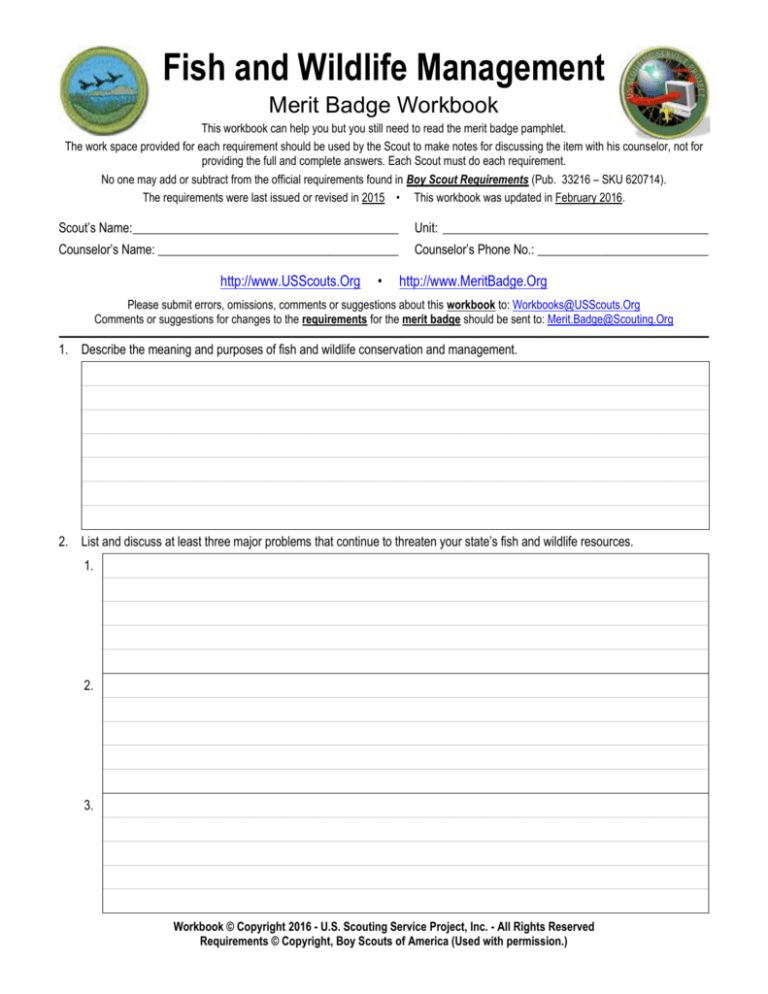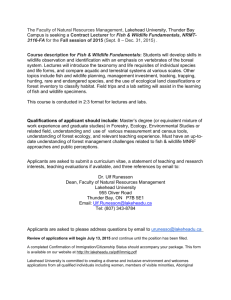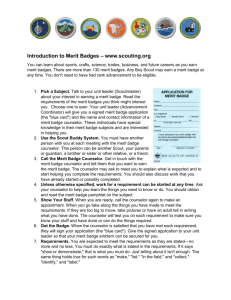
Fish and Wildlife Management
Merit Badge Workbook
This workbook can help you but you still need to read the merit badge pamphlet.
The work space provided for each requirement should be used by the Scout to make notes for discussing the item with his counselor, not for
providing the full and complete answers. Each Scout must do each requirement.
No one may add or subtract from the official requirements found in Boy Scout Requirements (Pub. 33216 – SKU 620714).
The requirements were last issued or revised in 2015 • This workbook was updated in February 2016.
Scout’s Name:__________________________________________
Unit: __________________________________________
Counselor’s Name: ______________________________________
Counselor’s Phone No.: ___________________________
http://www.USScouts.Org
•
http://www.MeritBadge.Org
Please submit errors, omissions, comments or suggestions about this workbook to: Workbooks@USScouts.Org
Comments or suggestions for changes to the requirements for the merit badge should be sent to: Merit.Badge@Scouting.Org
______________________________________________________________________________________________________________________________________________
1. Describe the meaning and purposes of fish and wildlife conservation and management.
2. List and discuss at least three major problems that continue to threaten your state’s fish and wildlife resources.
1.
2.
3.
Workbook © Copyright 2016 - U.S. Scouting Service Project, Inc. - All Rights Reserved
Requirements © Copyright, Boy Scouts of America (Used with permission.)
Fish and Wildlife Management
Scout's Name: ________________________
3. Describe some practical ways in which everyone can help with the fish and wildlife conservation effort.
4. List and describe five major fish and wildlife management practices used by managers in your state.
1.
2.
3.
4.
5.
Fish and Wildlife Management - Merit Badge Workbook
Page. 2 of 8
Fish and Wildlife Management
Scout's Name: ________________________
5. Do ONE of the following:
a. Construct, erect, and check regularly at least two artificial nest boxes (wood duck, bluebird, squirrel, etc.) and keep
written records for one nesting season.
b. Construct, erect, and check regularly bird feeders and keep written records of the kinds of birds visiting the feeders.
c. Design and implement a backyard wildlife habitat improvement project and report the results.
d. Design and construct a wildlife blind near a game trail, water hole, salt lick, bird feeder, or birdbath and take good
photographs or make sketches from the blind of any combination of 10 wild birds, mammals, reptiles, or amphibians.
6. Do ONE of the following:
a. Observe and record 25 species of wildlife. Your list may include mammals, birds, reptiles, amphibians, and fish.
Write down when and where each animal was seen.
Species
When seen
Where seen:
1.:
2.:
3.:
4.:
5.:
6.:
7.:
8.:
9.:
10.:
11.:
Fish and Wildlife Management - Merit Badge Workbook
Page. 3 of 8
Fish and Wildlife Management
Scout's Name: ________________________
12.:
13.:
14.:
15.:
16.:
17.:
18.:
19.:
20.:
21.:
22.:
23.:
24.:
25.:
b. List the wildlife species in your state that are classified as endangered, threatened, exotic, game species,
furbearers, or migratory game birds.
Wildlife Species
Endangered
Threatened
Exotic
Game
Species
Furbearer
Migratory
Game
Bird
c. Start a scrapbook of North American wildlife. Insert markers to divide the book into separate parts for mammals,
birds, reptiles, amphibians, and fish. Collect articles on such subjects as life histories, habitat, behavior, and feeding
habits on all of the five categories and place them in your notebook accordingly. Articles and pictures may be taken
from newspapers or science, nature, and outdoor magazines, or from other sources including the Internet (with your
parent’s permission). Enter at least five articles on mammals, five on birds, five on reptiles, five on amphibians, and
five on fish. Put each animal on a separate sheet in alphabetical order. Include pictures whenever possible.
Fish and Wildlife Management - Merit Badge Workbook
Page. 4 of 8
Fish and Wildlife Management
Scout's Name: ________________________
7. Do ONE of the following:
a. Determine the age of five species of fish from scale samples or identify various age classes of one species in a lake
and report the results.
Determine the age of five species of fish from scale samples
Fish Species 1:
Age:
Fish Species 2:
Age:
Fish Species 3:
Age:
Fish Species 4:
Age:
Fish Species 5:
Age:
Identify various age classes of one species in a lake and report the results.
b. Conduct a creel census on a small lake to estimate catch per unit effort.
c. Examine the stomach contents of three fish and record the findings. It is not necessary to catch any fish for this
option. You must visit a cleaning station set up for fishermen or find another, similar alternative.
Fish Species 1:
Stomach
contents:
Fish Species 2
Stomach
contents:
Fish and Wildlife Management - Merit Badge Workbook
Page. 5 of 8
Fish and Wildlife Management
Scout's Name: ________________________
Fish Species 3
Stomach
contents:
d. Make a freshwater aquarium. Include at least four species of native plants and four species of animal life, such as
whirligig beetles, freshwater shrimp, tadpoles, water snails, and golden shiners.
Plants
1.
2.
3.
4.
Animal life
1
2.
3.
4.
After 60 days of observation, discuss with your counselor the life cycles, food chains, and management needs you
have recognized
life cycles
food chains
management
needs
Fish and Wildlife Management - Merit Badge Workbook
Page. 6 of 8
Fish and Wildlife Management
Scout's Name: ________________________
After completing requirement 7d to your counselor’s satisfaction, with your counselor’s assistance, check local laws
to determine what you should do with the specimens you have collected.
8. Using resources found at the library and in periodicals, books, and the Internet (with your parent’s permission), learn about
three different kinds of work done by fish and wildlife managers.
1.
2.
3.
Requirement resources can be found here:
http://www.meritbadge.org/wiki/index.php/Fish and Wildlife Management#Requirement resources
Fish and Wildlife Management - Merit Badge Workbook
Page. 7 of 8
Important excerpts from the Guide To Advancement - 2013, No. 33088 (SKU-618673)
[1.0.0.0] — Introduction
The current edition of the Guide to Advancement is the official source for administering advancement in all Boy Scouts of America programs: Cub
Scouting, Boy Scouting, Varsity Scouting, Venturing, and Sea Scouts. It replaces any previous BSA advancement manuals, including Advancement
Committee Policies and Procedures, Advancement and Recognition Policies and Procedures, and previous editions of the Guide to Advancement.
[Page 2, and 5.0.1.4] — Policy on Unauthorized Changes to Advancement Program
No council, committee, district, unit, or individual has the authority to add to, or subtract from, advancement requirements. There are limited
exceptions relating only to youth members with special needs. For details see section 10, “Advancement for Members With Special Needs”.
[Page 2] — The “Guide to Safe Scouting” Applies
Policies and procedures outlined in the Guide to Safe Scouting, No. 34416, apply to all BSA activities, including those related to advancement and
Eagle Scout service projects.
[7.0.3.1] — The Buddy System and Certifying Completion
A youth member must not meet one-on-one with an adult. Sessions with counselors must take place where others can view the interaction, or the
Scout must have a buddy: a friend, parent, guardian, brother, sister, or other relative—or better yet, another Scout working on the same badge—along
with him attending the session.
When the Scout meets with the counselor, he should bring any required projects. If these cannot be transported, he should present evidence, such as
photographs or adult verification. His unit leader, for example, might state that a satisfactory bridge or tower has been built for the Pioneering merit
badge, or that meals were prepared for Cooking. If there are questions that requirements were met, a counselor may confirm with adults involved.
Once satisfied, the counselor signs the blue card using the date upon which the Scout completed the requirements, or in the case of partials, initials
the individual requirements passed.
Note that from time to time, it may be appropriate for a requirement that has been met for one badge to also count for another. See “Fulfilling More
Than One Requirement With a Single Activity,” 4.2.3.6.
[7.0.3.2] — Group Instruction
It is acceptable—and sometimes desirable—for merit badges to be taught in group settings. This often occurs at camp and merit badge midways or
similar events. Interactive group discussions can support learning. The method can also be attractive to “guest experts” assisting registered and
approved counselors. Slide shows, skits, demonstrations, panels, and various other techniques can also be employed, but as any teacher can attest,
not everyone will learn all the material.
There must be attention to each individual’s projects and his fulfillment of all requirements. We must know that every Scout —actually and
personally— completed them. If, for example, a requirement uses words like “show,” “demonstrate,” or “discuss,” then every Scout must do that. It is
unacceptable to award badges on the basis of sitting in classrooms watching demonstrations, or remaining silent during discussions.
It is sometimes reported that Scouts who have received merit badges through group instructional settings have not fulfilled all the requirements. To
offer a quality merit badge program, council and district advancement committees should ensure the following are in place for all group instructional
events.
Merit badge counselors are known to be registered and approved.
Any guest experts or guest speakers, or others assisting who are not registered and approved as merit badge counselors, do not accept the
responsibilities of, or behave as, merit badge counselors, either at a group instructional event or at any other time. Their service is temporary, not
ongoing.
Counselors agree not to assume prerequisites have been completed without some level of evidence that the work has been done. Pictures and
letters from other merit badge counselors or unit leaders are the best form of prerequisite documentation when the actual work done cannot be
brought to the camp or site of the merit badge event.
There is a mechanism for unit leaders or others to report concerns to a council advancement committee on summer camp merit badge programs,
group instructional events, and any other merit badge counseling issues—especially in instances where it is believed BSA procedures are not
followed. See “Reporting Merit Badge Counseling Concerns,” 11.1.0.0.
There must be attention to each individual’s projects and his fulfillment of all requirements. We must know that every Scout—actually and
personally—completed them.
[7.0.3.3] — Partial Completions
A Scout need not pass all the requirements of one merit badge with the same counselor. It may be that due to timing or location issues, etc., he must
meet with a different counselor to finish the badge. The Application for Merit Badge has a place to record what has been finished—a “partial.” In the
center section on the reverse of the blue card, the counselor initials for each requirement passed. In the case of a partial completion, the counselor
does not retain his or her portion of the card. A subsequent counselor may choose not to accept partial work, but this should be rare. A Scout, if he
believes he is being treated unfairly, may work with his unit leader to find another counselor. An example for the use of a signed partial would be to
take it to camp as proof of prerequisites. Partials have no expiration except the Scout’s 18th birthday. Units, districts, or councils shall not establish
other expiration dates for partial merit badges.
[7.0.4.8] — Unofficial Worksheets and Learning Aids
Worksheets and other materials that may be of assistance in earning merit badges are available from a variety of places including unofficial sources
on the Internet and even troop libraries. Use of these aids is permissible as long as the materials can be correlated with the current requirements that
Scouts must fulfill. Completing “worksheets” may suffice where a requirement calls for something in writing, but this would not work for a requirement
where the Scout must discuss, tell, show, or demonstrate, etc. Note that Scouts shall not be required to use these learning aids in order to complete a
merit badge.
Attachment
(NOTE: It is not necessary to print this page.)
Page 8 of 8








